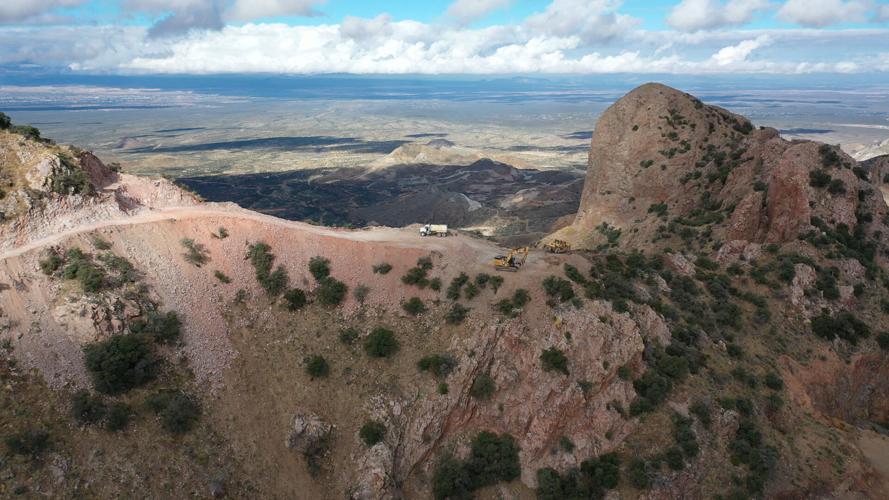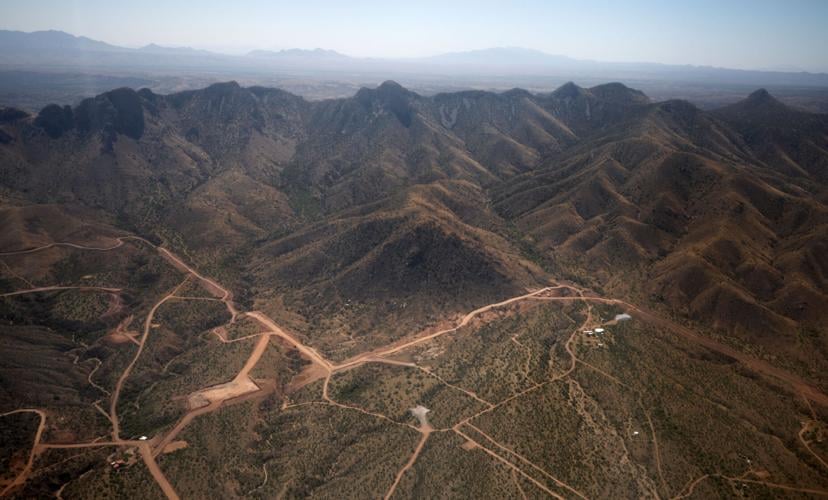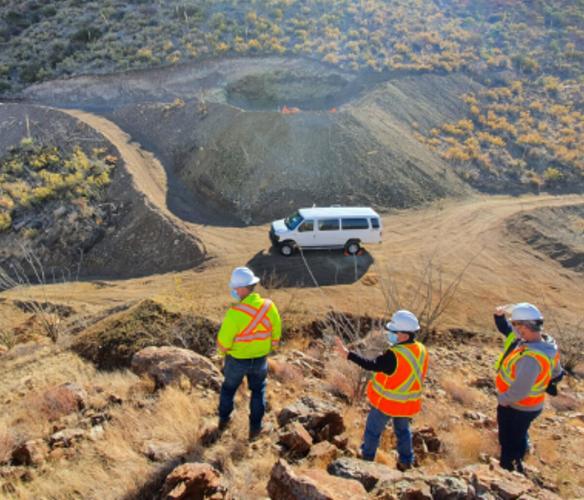The Arizona Department of Environmental Quality proposes to approve a groundwater protection permit for the massive Copper World mining complex to regulate and require monitoring of pollutant discharges from 16 facilities.
Those facilities planned for the Santa Rita Mountains site include five open pits, with a sixth pit not expected to discharge anything due to its makeup and size. There will be two huge tailings storage and disposal areas, spanning 946 and 307 acres, respectively, with both reaching more than 250 feet high, higher than a 20-story building.
A waste rock disposal facility will cover about 725 acres and will hold rock removed from the pits that has metal concentrations too low to be economically processed. Various ponds will store or capture storm-water runoff, water reclaimed from copper sulfide processing, water that drains from the tailings and a solution left over from copper oxide processing.
At a state-run public hearing Tuesday on ADEQ’s draft permit, the 45 commenters were split between those who took direct aim at the permit as inadequate; those who said Copper World will be vital for both the Tucson-area economy and the future “green economy”; and those who said the mine will assault the Santa Ritas’ beauty and biological diversity.
Overall, mine opponents significantly outnumbered supporters who spoke.
ADEQ’s draft permit covers 57 pages and requires Hudbay Minerals Inc. to “operate and maintain all permitted facilities to prevent unauthorized discharges.”
The permit is one of only two major permits that Hudbay needs to be able to build the Copper World mine. The other is an ADEQ air quality permit, which is also pending. Because the land for Copper World on the Santa Ritas’ west slope is privately owned, Hudbay doesn’t need any federal permits for it.
It will eventually need federal approval to dig an open pit and start mining on the Santa Ritas’ east slope because much of that side of the mountain is U.S. Forest Service land. Mine construction on that side of the Santa Ritas has been stalled because federal courts have refused to go along with Hudbay’s earlier proposal to dump some of its mine waste rock and tailings on national forest land there.
Tuesday’s hearing was boisterous, with many of the 200 people in the audience cheering, booing and hissing at the most strongly worded comments from opponents and supporters.
The hearing came two weeks after an equally large crowd at a public meeting mostly grilled ADEQ officials with piercing questions on what they saw as the permit’s flaws. At that session, ADEQ officials responded to the questions, but they weren’t allowed to do so at Tuesday’s session, under the department’s rules for public hearings.
Instead, ADEQ officials told the crowd they can respond later in writing to questions posed at the hearing. Or the public can send written questions until the department’s public comment period on the permit expires April 10, and get written responses afterward.
Some of the harshest critics at Tuesday’s hearing complained the permit’s proposed monitoring plan is inadequate, that it lacks legal standards for some of the chemicals to be used at the mine, and that some of the facilities that will hold mine wastes won’t be lined to stop liquids from seeping into the aquifer.
But those comments were much less common than at the earlier public meeting. The leading opposition group, Save the Scenic Santa Ritas, had asked residents to ask ADEQ detailed questions at the earlier meeting. But this time, their list of questions was shorter and more focused, said Rob Peters, the group’s executive director. The group has hired three experts to analyze the draft permit in more detail and will submit critical comments on it before the comment period expires, he said.
A typical opponent comment at Tuesday’s hearing came from Peggy Ollerhead of Tucson, who said she was “shocked and saddened when I was here at the last meeting there would be nothing done for first two years” for groundwater monitoring before the mine starts operations.
“We know Hudbay has already started construction on the site, which is likely to have an impact on groundwater quality and the quality of our environment,” said Ollerhead, representing the group Great Old Broads for Wilderness.
“They’re not being asked to do any pre-measures. In terms of monitoring the quality of the aquifer, that needs to happen ahead of time. You need a baseline. That’s just a basic research measure,” she said.
Many pro-mine speakers said Copper World will give a huge boost to Southern Arizona’s economy and that more copper is needed as ingredients for solar panels, wind farms and electric vehicles.
“Unfortunately, most people have no idea of where materials come from for this green movement,” testified Dennis Fischer, a former geologist for Augusta Resource Corp. “There’s 176 pounds of copper in an electric vehicle, four times the amount of copper in a combustion engine vehicle.
“There’s 2,000 pounds of copper in a standard wind turbine. A photovoltaic solar plant contains about 5.5 tons of copper per megawatt of power generation,” Fischer said in comments that drew loud hoots, applause and boos from various segments of the audience.
Augusta had sought to build the proposed Rosemont Mine on some of the same Santa Ritas land now planned for mining by Toronto-based Hudbay, before Augusta sold out to Hudbay in 2014.
Fischer noted that Arizona produces about 68% of all U.S.-based copper supplies, and that an estimated 38,000 to 39,000 jobs in Arizona are connected to mining in some way — “which is why we are the copper state.”
Mine opponent Bryan Slabaugh of Sahuarita called it “absurd” that Hudbay will be monitoring groundwater quality rather than ADEQ or an independent third party. ADEQ has said self-monitoring is mandated by the Legislature.
“This would be like putting prisoners in charge of running our prisons,” said Slabaugh. “Our groundwater is falling deeper and deeper every year. The last thing we need is a mine pumping more of our groundwater.
“They say copper is needed for green energy, but green energy is a sham. Nuclear power should be the main supplier of our future energy. Electric cars have a short life span. I served 10 years in the military, and put my life on the line so America could prosper, not so a Canadian company can come in and destroy our land, water and way of life,” Slabaugh said.
Mark Davis, a Tucsonan who represented the mining industry trade and lobbying group Amigos, said Copper World is an opportunity to add thousands of good paying jobs — “we pay above what other industries do” — with good benefits. Hudbay has said Copper World will create 400 permanent jobs and indirectly create another 3,000 jobs.
“I’ve spent most of my career in mining. The mining industry is a blessing that enabled my family to realize the American dream, the opportunity to work hard and leave a better world behind,” Davis said.
Details of permit, mine plans
Copper World’s mine life for its first phase is expected to be 15 years, ADEQ’s draft permit says, although a planned second phase could extend the project’s life much longer. Other details contained in the permit include:
The mine will extract about 277 million tons of copper sulfide ore over its first phase, along with about 103 million tons of copper oxide ore.
The mining company anticipates Copper World will require more than two years of production before mining can start. Closing down the mine after its life is over is anticipated to take one to two years, and monitoring and other activities at the site will continue another 30 years.
Meeting the permit’s requirements will let Hudbay comply with the two key requirements for the state’s Aquifer Protection Program. That program was put in place by the Legislature nearly 40 years ago to give groundwater its first major state-managed protections from pollution through laws and regulations.
First, the draft permit will ensure that pollutants discharged by Copper World won’t “cause or contribute” to a violation of a state Aquifer Water Quality Standard at any of 10 monitoring wells where compliance with the rules will be enforced, the state says. Or the pollution won’t further degrade an aquifer that already has water quality violations before mining begins, ADEQ says.
Second, the mine will use what ADEQ calls the Best Available Demonstrated Control Technology.
That can include engineering controls, processes, operating methods or other alternatives to reduce pollutant discharges to the greatest amount practical before they reach the aquifer or prevent them from reaching the aquifer, the agency says.
Hudbay will have to monitor for a host of contaminants in its 10 monitoring wells — some four times a year, some every other year. Among the 25 pollutants requiring quarterly monitoring are cadmium, nitrates, uranium, barium, arsenic, cyanide, lead, mercury and nickel.
Competing opinions
Lee Mayes, who called himself a third-generation copper miner, said he worked 32 years at the now-shuttered San Manuel copper mine near Tucson. For its last 16 years it had a solvent-extraction facility to extract copper oxides, “just like Copper World is proposing,” he said.
“I also helped design copper facilities like this. It’s amazing the work ADEQ does to protect our resources. I have full confidence in ADEQ. I’ve seen operations scramble (at mines), when you have a release” of contaminants, he said.
“Chile and China are big copper producers. Those aren’t guaranteed that that stuff gets over here. We see in Chile, their resources are dwindling down. Copper is going to get real expensive pretty soon. It’s good we have something here.”
But Pima County Supervisor Matt Heinz, a Democrat whose district includes the Copper World site, asked ADEQ to “do everything in your power” to deny the permit, saying the mine will be built over an aquifer providing water for thousands of people and businesses.
“Pumping that water out of our aquifer, polluting it with the harsh chemicals needed for mining and extraction, then allowing that water to filtrate through the soil back into the aquifer is counterintuitive and works against years of progress to ensure a clean, reliable drinking water source for generations,” said Heinz, in written testimony read at the hearing by an aide.
“Surely ADEQ can write a more protective permit that would require a third party to verify Hudbay’s monitoring reports and a thorough sampling of the aquifer now, before any mining activity begins,” Heinz said.
Some opponents acknowledged their lack of technical knowledge about the permit, but said the mountains southeast of Tucson have personal meaning for them and are worth preserving for their own sake.
Alison Soland, 19, of Tucson, said the Santa Ritas helped her recover at age 15 from a four-year drug addiction. That happened after she joined the Arizona Trails Association, where she learned about connecting with nature in general and the Sonoran Desert in particular. Later, she fell in love with her current fiancé in the Santa Ritas, she said. A year ago, she gave up a chance to attend Cornell University in New York after deciding she’d rather stay in Tucson and teach people about the Sonoran Desert.
“None of this has any statistics or anything that will help you guys with your studies,” Soland told a row of ADEQ officials at the hearing. “It really matters to me, and I don’t want to see it taken away. Over the next couple of years, we will continue to get mine after mine, and over the next 20 years, there won’t be any more mountains to protect, or any air or water to protect.”
Get your morning recap of today's local news and read the full stories here: tucne.ws/morning





